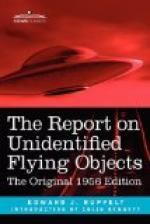In the debate which followed, the proponents of the high-flying theory won out, and the F-86’s were told to go up to 40,000 feet. But before the aircraft could get to that altitude, the target had been completely lost on the radarscope.
The F-86’s continued to search the area at 40,000 feet, but could see nothing. After a few minutes the aircraft ground controller called the F-86’s and told one to come down to 20,000 feet, the other to 5,000 feet, and continue the search. The two jets made a quick letdown, with one pilot stopping at 20,000 feet and the other heading for the deck.
The second pilot, who was going down to 5,000 feet, was just beginning to pull out when he noticed a flash below and ahead of him. He flattened out his dive a little and headed toward the spot where he had seen the light. As he closed on the spot he suddenly noticed what he first thought was a weather balloon. A few seconds later he realized that it couldn’t be a balloon because it was staying ahead of him. Quite an achievement for a balloon, since he had built up a lot of speed in his dive and now was flying almost straight and level at 3,000 feet and was traveling “at the Mach.”
Again the pilot pushed the nose of the F-86 down and started after the object. He closed fairly fast, until he came to within an estimated 1,000 yards. Now he could get a good look at the object. Although it had looked like a balloon from above, a closer view showed that it was definitely round and flat—saucer-shaped. The pilot described it as being “like a doughnut without a hole.”
As his rate of closure began to drop off, the pilot knew that the object was picking up speed. But he pulled in behind it and started to follow. Now he was right on the deck.
About this time the pilot began to get a little worried. What should he do? He tried to call his buddy, who was flying above him somewhere in the area at 20,000 feet. He called two or three times but could get no answer. Next he tried to call the ground controller but he was too low for his radio to carry that far. Once more he tried his buddy at 20,000 feet, but again no luck.
By now he had been following the object for about two minutes and during this time had closed the gap between them to approximately 500 yards. But this was only momentary. Suddenly the object began to pull away, slowly at first, then faster. The pilot, realizing that he couldn’t catch it, wondered what to do next.
When the object traveled out about 1,000 yards, the pilot suddenly made up his mind—he did the only thing that he could do to stop the ufo. It was like a David about to do battle with a Goliath, but he had to take a chance. Quickly charging his guns, he started shooting. . . . A moment later the object pulled up into a climb and in a few seconds it was gone. The pilot climbed to 10,000 feet, called the other F-86, and now was able to contact his buddy. They joined up and went back to their base.




